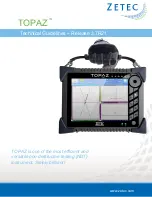
Page 3 of 68
PN-3078-0001 Rev. C 01/13
English
INSTRUCTIONS FOR USE
AngioSculpt® Percutaneous Transluminal Coronary Angioplasty (PTCA)
Scoring Balloon Catheter
Rapid Exchange (RX) Delivery System
NOTE: These instructions apply to all balloon diameters and
lengths.
STERILE: Sterilized with ethylene oxide gas. Do not use if the package
is open or damaged.
CONTENTS: One (1) AngioSculpt® Scoring Balloon Catheter.
STORAGE: Store in a dry, dark, cool place.
I.
DEVICE DESCRIPTION
The AngioSculpt catheter comprises a standard balloon catheter that
incorporates a nitinol component. The proximal end of the catheter is
a common PTCA catheter design comprising a hypotube connected
to a plastic hub. The hub-hypotube contact area is supported by a
relatively soft strain relief to avoid kinking. The hub is used to inflate
the balloon and can be connected to a standard inflation device. The
distal part of the catheter consists of a conventional nylon balloon and
a laser-cut nitinol scoring element having three or more spiral struts
that wrap around the balloon. The struts create focal concentrations
of dilating force, which minimizes balloon slippage and assists in
the luminal expansion of stenotic coronary arteries. The catheter is
compatible with standard 0.014” coronary guide wires and 6F guiding
catheters. The catheter length is approximately 137 cm and is offered in
diameters of 2.0 – 3.5 mm in 0.5 mm increments. The working length of
the scoring element ranges from 6 to 20 mm. The catheter is supplied
sterile and is intended for a single use. Figure 1 below depicts the
AngioSculpt catheter.
Figure 1: AngioSculpt Catheter
II. INDICATIONS
The AngioSculpt Scoring Balloon Catheter is indicated for the
treatment of a hemodynamically significant coronary artery stenosis,
including in-stent restenosis, for the purpose of improving myocardial
perfusion.
III. CONTRAINDICATIONS
The AngioSculpt catheter should not be used for the following:
• Coronary artery lesions unsuitable for treatment by percutaneous
revascularization.
• Coronary artery spasm in the absence of a significant stenosis.
IV. WARNINGS
• This device is intended for single (one) use only. Do not resterilize
and/or reuse, as this can potentially result in compromised device
performance and increased risk of inappropriate resterilization and
cross contamination.
• To reduce the potential for vessel damage, the inflated diameter
of the balloon should approximate the diameter of the vessel just
proximal and distal to the stenosis.
• PTCA in patients who are not acceptable candidates for coronary
artery bypass graft surgery requires careful consideration, including
possible hemodynamic support during PTCA, as treatment of this
patient population carries special risk.
• When the catheter is exposed to the vascular system, it should be
manipulated while under high quality fluoroscopic observation. Do
not advance or retract the catheter unless the balloon is fully deflated
under vacuum. If resistance is met during manipulation, determine
the cause of the resistance before proceeding.
• Balloon pressure should not exceed the rated burst pressure (RBP).
[The RBP is based on results of in-vitro testing. At least 99.9% of the
balloons (with 95% confidence) will not burst at or below their RBP.
Use of a pressure monitoring device is recommended to prevent
over-pressurization.]
• PTCA with the AngioSculpt device should only be performed at
hospitals where emergency coronary artery bypass graft surgery can
be quickly performed on site (or at a nearby facility) in the event of a
potentially injurious or life-threatening complication.
• Use only the recommended balloon inflation medium. Never use air
or any gaseous medium to inflate the balloon.
• Proceed cautiously when using the AngioSculpt catheter in a freshly
deployed bare metal or drug eluting stent. The AngioSculpt catheter
has not been tested for post-dilation of stents or lesions distal to
freshly deployed stents in clinical studies. Bench testing has shown
no additional risk when inserting or withdrawing the AngioSculpt
catheter through stents (no interference with stent struts, no
retention of or damage to AngioSculpt catheter).
• Use the catheter prior to the “Use Before” (expiration) date specified
on the package.
V. PRECAUTIONS
• Prior to angioplasty, the catheter should be examined to verify
functionality, device integrity and to ensure that its size and length
are suitable for the specific procedure for which it is to be used.
• Only physicians trained in the performance of percutaneous
transluminal coronary angioplasty should use the catheter system.
• During and after the procedure, appropriate antiplatelet,
anticoagulant and coronary vasodilator therapy consistent with
institutional practice for coronary stent procedures should be
provided to the patient.
• Do not rotate the catheter shaft in excess of 180 degrees when the
tip is constrained.
• Do not rotate the catheter luer hub in excess of five (5) turns during
use.
• Do not advance or retract the AngioSculpt catheter over the floppy
portion of the guide wire.
• Catheter manipulation, including advancement and retraction,
should be performed by grasping the hypotube shaft.
• If unusual resistance is felt when the catheter is being manipulated
or if it is suspected that the guide wire has become kinked, carefully
remove the entire catheter system (AngioSculpt catheter and
steerable guide wire) as a unit.
• If fluoroscopic guidance indicates that the AngioSculpt catheter has
advanced beyond the end of the guide wire, withdraw the catheter
and reload the wire before advancing again.




































